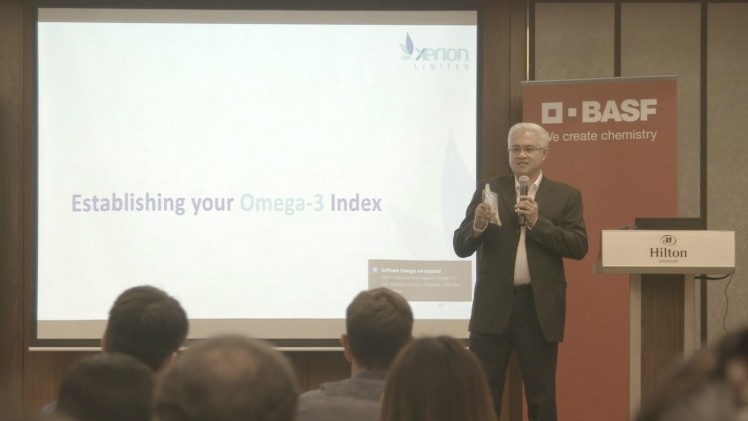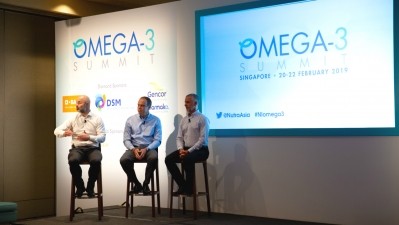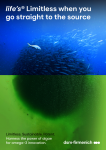NutraIngedients Omega-3 Summit
Tech and testing: Time to convince consumers to monitor their omega-3 Index

At the recent NutraIngredients Omega-3 Summit in Singapore, Xerion presented its proprietary technology, PUFAcoat, at a breakfast briefing organised by BASF. Guests were given the opportunity to test their Omega-3 Index using dried blood spot technology.
Xerion's testing kit was first launched last year, with BASF gaining exclusive distribution rights to market the product as part of a three-year agreement between the two companies.
The breakfast session opened with BASF's senior VP of Global Human Nutrition, François Scheffler, welcoming delegates and highlighting the importance of compliance in omega-3 consumption, which could be facilitated to a significant extent by convenient and accurate testing.
He said, "We recognise the importance of getting the right nutrition to the right people at the right time. Compliance has a lot to do with (accessibility to) measurement, so I'm delighted that we have Xerion on board to help make Omega-3 Index easier and more accurate."
GOED executive director followed, acknowledging BASF's contributions to increasing omega-3 awareness and intake, and emphasising the need to educate not only consumers, but healthcare practitioners as well.
Convenience and accuracy
Xerion's chief scientific officer Dr Leodevico Ilag then took the stage, first crediting the University of Adelaide's Prof Robert Gibson, Dr Liu Ge and Dr Beverly Mühlhäusler as the brains behind the PUFAcoat technology, saying: "The technology was developed, incidentally, with preterm babies in mind.
"One of the Robert's concerns when developing this technology was to find a convenient and effective way to collect samples from preterm babies. The technology also had to be adaptable, since the samples had to be transported and their stability and integrity maintained."
Ilag then presented the findings from studies conducted on the technology, which showed that it was able to effectively stabilise long-chain polyunsaturated fatty acids (PUFAs) for analysis.
The study results further showed that PUFAcoat could stabilise EPA and DHA on a solid matrix for up to nine weeks at room temperature and up to two weeks at 40°C, maximising the accuracy Omega-3 Index readings.
So far, the kits themselves have undergone testing in clinical trials in Singapore, Australia and New Zealand, whereby the stability of the dried blood samples' fatty acids they collected was assessed at both room temperature and higher temperatures.
Using the kits, BASF has since gone on to conduct trials to investigate the link between the Omega-3 Index and specific health outcomes.
In addition, the kit will enable users to measure not only their EPA and DHA levels, but the levels of other fatty acids in their blood as well, affording them a more extensive degree of awareness of their own health.
Live testing
Each of the delegates present was also provided with a testing kit, which Ilag demonstrated how to use.
He told them: "It's pretty much the same as any other dried blood spot testing, but the PUFAcoat technology ensures you will get a high degree of accuracy in your Omega-3 Index reading.
"Also, the reason we chose this lancet you will find in your kit is that we found its usage to be almost painless."
He guided them through the necessary steps, which involved the simple process of cleaning the index finger with an alcohol swab, drawing blood from it with the lancet provided, and collecting blood spot samples with a designated collection card that was also part of the kit.
Once the samples were dry, the cards were collected by BASF, who would then send the dried blood spot samples to Australia for testing before mailing the results to the respective attendees.
Ilag also detailed the testing kit’s current regulatory approvals: under Australia's Therapeutic Goods Administration (TGA), the blood collection card is listed as a Class 1 Medical Device, while the kit itself is listed as a Class 2A Medical Device.
At the moment, Xerion's application for kit to obtain the CE Mark in Europe is still under review.
Ilag said, "We're happy to have partnered with BASF in delivering a method by which we can measure the Omega-3 Index more conveniently and accurately.
"(This summit) has been a convergence of what we were discussing four-and-a-half years ago, when we licensed the technology from the University of Adelaide."

















